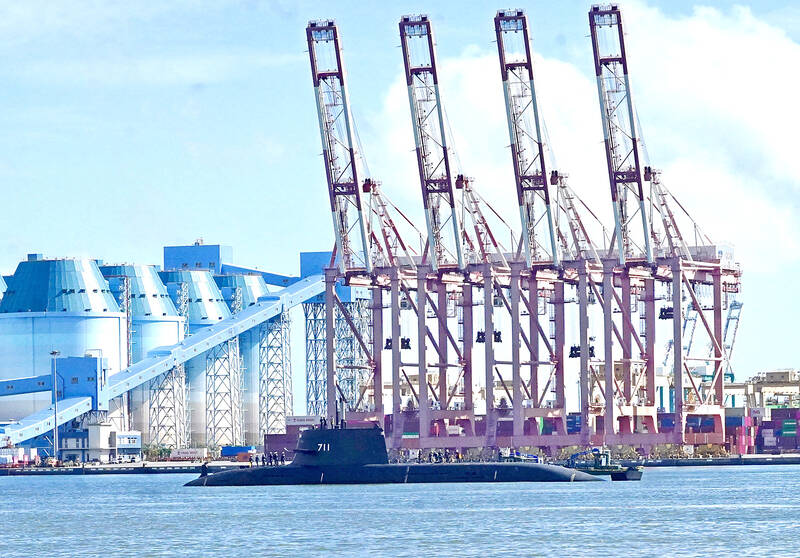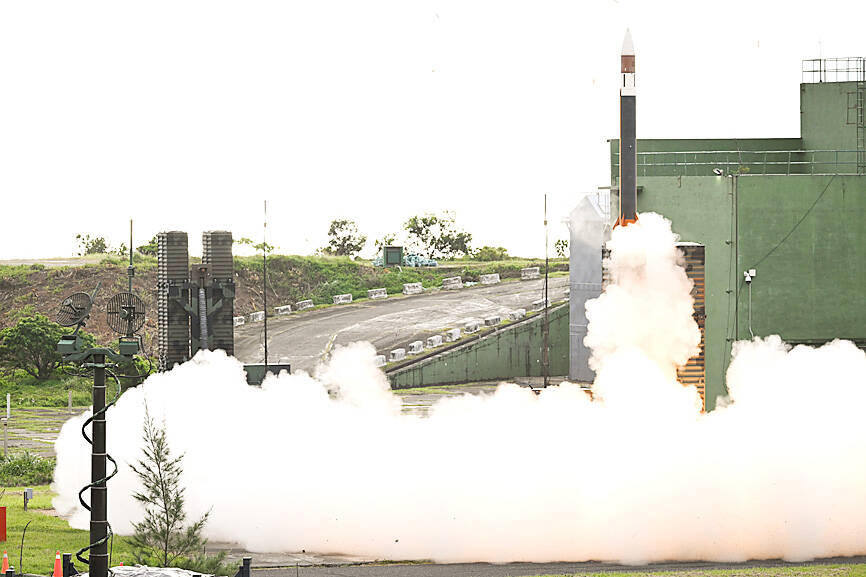The Ministry of National Defense is to propose a special budget to replace the military’s currently fielded command and control system, bolster defensive resilience and acquire more attack drones, a senior defense official said yesterday.
The budget would be presented to the legislature in August, the source said on condition of anonymity.
Taiwan’s decade-old Syun An (迅安, “Swift Security”) command and control system is a derivative of Lockheed Martin’s Link-16 developed under Washington’s auspices, they said.

Photo: CNA
The Syun An system is difficult to operate, increasingly obsolete and has unresolved problems related to integrating disparate tactical data across the three branches of the military, they said.
The US has agreed to assist Taiwan in developing a new command and control system, they said.
The new system would be based on the US-made Link-22 to offer superior over-the-horizon capabilities, resistance to jamming and sufficient interoperability for achieving a common operational picture with NATO forces, they said.

Photo: Chen Yi-kuan, Taipei Times
The ministry has not concluded talks with the US regarding the procurement of asymmetric capabilities and systems related to the resilient defense concept, the official said.
This means that previous media reports alleging the ministry had allocated NT$300 billion to NT$500 billion (US$10.1 billion to US$16.9 billion) to these programs were not correct, they said.
The Sea-Air Combat Power Improvement Plan is drawing to a close, with production of Wan Chien missiles, Hsiung Sheng missiles and various uncrewed vehicles either completed or nearing completion, they said.
This means that the ministry would fund the production of additional batches of Hsiung Feng III (“Brave Wind III”) anti-ship missiles and new weapons developed by the Chungshan Institute of Science and Technology’s Chiang Kung Program with its regular annual budget, they said.
The Chiang Kung Program has produced two new weapons, one known as the Tien Kung IV (Sky Bow IV), and another weapon temporarily dubbed the Chiang Kung IIA/B, its codename under the project.
The Tien Kung IV is an anti-ballistic missile with a maximum altitude of 70km, more than any variant of the Patriot Advanced Capability-3 missiles.
The Chiang Kung IIA is an anti-ballistic missile capable of reaching an altitude of 100km, equivalent to the US-made Terminal High Altitude Area Defense missile, and Chiang Kung IIB, a surface-to-surface weapon with an effective range of 1,000km.
Separately, the nation’s prototype attack submarine Hai Kun (海鯤, “Narwhal”) yesterday initiated the final phase of the harbor acceptance test, putting the boat on the verge of completing a developmental milestone.
The submarine requested and obtained permission to sail in a loop three times in the seas off the Port of Kaohsiung, records obtained by the Chinese-language Liberty Times (the Taipei Times’ sister paper) showed.
The Hai Kun was photographed by members of the public sailing in the waters with the bow number visible.
When asked, a source said on condition of anonymity that the submarine was testing its propulsion system and would sail further out to sea if yesterday’s trial proved successful.
The Hai Kun’s harbor acceptance test had initially been scheduled for April, but was subsequently delayed.
Navy Chief of Staff Vice Admiral Chiu Chun-jung (邱俊榮) last month said that the target of delivering the Hai Kun by November remained unchanged.

The US government has signed defense cooperation agreements with Japan and the Philippines to boost the deterrence capabilities of countries in the first island chain, a report by the National Security Bureau (NSB) showed. The main countries on the first island chain include the two nations and Taiwan. The bureau is to present the report at a meeting of the legislature’s Foreign Affairs and National Defense Committee tomorrow. The US military has deployed Typhon missile systems to Japan’s Yamaguchi Prefecture and Zambales province in the Philippines during their joint military exercises. It has also installed NMESIS anti-ship systems in Japan’s Okinawa

‘WIN-WIN’: The Philippines, and central and eastern European countries are important potential drone cooperation partners, Minister of Foreign Affairs Lin Chia-lung said Minister of Foreign Affairs Lin Chia-lung (林佳龍) in an interview published yesterday confirmed that there are joint ventures between Taiwan and Poland in the drone industry. Lin made the remark in an exclusive interview with the Chinese-language Liberty Times (the Taipei Times’ sister paper). The government-backed Taiwan Excellence Drone International Business Opportunities Alliance and the Polish Chamber of Unmanned Systems on Wednesday last week signed a memorandum of understanding in Poland to develop a “non-China” supply chain for drones and work together on key technologies. Asked if Taiwan prioritized Poland among central and eastern European countries in drone collaboration, Lin

NO CONFIDENCE MOTION? The premier said that being toppled by the legislature for defending the Constitution would be a democratic badge of honor for him Premier Cho Jung-tai (卓榮泰) yesterday announced that the Cabinet would not countersign the amendments to the local revenue-sharing law passed by the Legislative Yuan last month. Cho said the decision not to countersign the amendments to the Act Governing the Allocation of Government Revenues and Expenditures (財政收支劃分法) was made in accordance with the Constitution. “The decision aims to safeguard our Constitution,” he said. The Constitution stipulates the president shall, in accordance with law, promulgate laws and issue mandates with the countersignature of the head of the Executive Yuan, or with the countersignatures of both the head of the Executive Yuan and ministers or

CABINET APPROVAL: People seeking assisted reproduction must be assessed to determine whether they would be adequate parents, the planned changes say Proposed amendments to the Assisted Reproduction Act (人工生殖法) advanced yesterday by the Executive Yuan would grant married lesbian couples and single women access to legal assisted reproductive services. The proposed revisions are “based on the fundamental principle of respecting women’s reproductive autonomy,” Cabinet spokesperson Michelle Lee (李慧芝) quoted Vice Premier Cheng Li-chiun (鄭麗君), who presided over a Cabinet meeting earlier yesterday, as saying at the briefing. The draft amendment would be submitted to the legislature for review. The Ministry of Health and Welfare, which proposed the amendments, said that experts on children’s rights, gender equality, law and medicine attended cross-disciplinary meetings, adding that